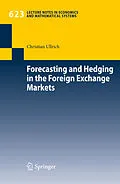The growing complexity of many real world problems is one of the biggest challenges of our time. The area of international finance is one prominent example where decision making is often fraud to mistakes, and tasks such as forecasting, trading and hedging exchange rates seem to be too difficult to expect correct or at least adequate decisions. From the high complexity of the foreign exchange market and related decision problems, the author derives the necessity to use tools from Machine Learning and Artificial Intelligence, e.g. Support Vector Machines, and to combine such methods with sophisticated financial modelling techniques. The suitability of this combination of ideas is demonstrated by an empirical study and by simulation.
Zusammenfassung
Historical and recent developments at international ?nancial markets show that it is easy to loose money, while it is dif?cult to predict future developments and op- mize decision-making towards maximizing returns and minimizing risk. One of the reasons of our inability to make reliable predictions and to make optimal decisions is the growing complexity of the global economy. This is especially true for the f- eign exchange market (FX market) which is considered as one of the largest and most liquid ?nancial markets. Its grade of ef?ciencyand its complexityis one of the starting points of this volume. From the high complexity of the FX market, Christian Ullrich deduces the - cessity to use tools from machine learning and arti?cial intelligence, e.g., support vector machines, and to combine such methods with sophisticated ?nancial mod- ing techniques. The suitability of this combination of ideas is demonstrated by an empirical study and by simulation. I am pleased to introduce this book to its - dience, hoping that it will provide the reader with interesting ideas to support the understanding of FX markets and to help to improve risk management in dif?cult times. Moreover, I hope that its publication will stimulate further research to contribute to the solution of the many open questions in this area.
Inhalt
Motivation.- Analytical Outlook.- Foreign Exchange Market Predictability.- Equilibrium Relationships.- Market Efficiency Concepts.- Views from Complexity Theory.- Conclusions.- Exchange Rate Forecasting with Support Vector Machines.- Statistical Analysis of Daily Exchange Rate Data..- Support Vector Classification.- Description of Empirical Study and Results.- Exchange Rate Hedging in a Simulation/Optimization Framework.- Preferences over Probability Distributions.- Problem Statement and Computational Complexity.- Model Implementation.- Simulation/Optimization Experiments.- Contributions of the Dissertation.- Exchange Rate Forecasting with Support Vector Machines.- References.- Exchange Rate Hedging in a Simulation/Optimization Framework.
Titel
Forecasting and Hedging in the Foreign Exchange Markets
Autor
EAN
9783642004957
ISBN
978-3-642-00495-7
Format
E-Book (pdf)
Hersteller
Herausgeber
Veröffentlichung
30.05.2009
Digitaler Kopierschutz
Wasserzeichen
Dateigrösse
2.8 MB
Anzahl Seiten
207
Jahr
2009
Untertitel
Englisch
Unerwartete Verzögerung
Ups, ein Fehler ist aufgetreten. Bitte versuchen Sie es später noch einmal.
